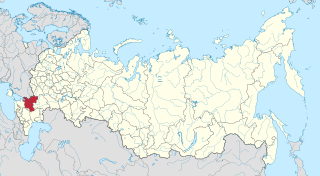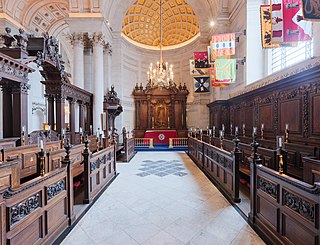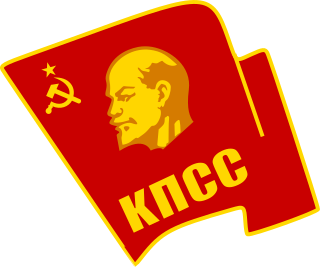
Church of the Ascension of the Lord ― an Orthodox church, built in 1910-1913 on the territory of the Brethren Cemetery in Rostov-on-Don, Russia. Construction of the temple was carried out at the expense of merchants Gerasimov, Myasnikov and Safonov. The project was drafted by architect Grigory Vasilyev. The main altar was consecrated in honor of the Ascension of the Lord. Side chapels ― in honor of saints Adrian and Natalia, and in honor of St. John the Evangelist. The church has the status of an object of cultural heritage of regional significance.

The Annunciation Greek Orthodox Church Russian: was a Greek Orthodox church constructed in 1909 in Rostov-on-Don. In Soviet times, the church was demolished, and the Puppet Theatre was built on its foundations. A new Greek church of the Annunciation was built close to the site of the demolished one in 2014.
Church of St. John of Kronstadt is an Orthodox church in the city of Rostov-on-Don, Russia. It belongs to Rostov and Novocherkassk Diocese of Moscow Patriarchate. It was built in 2010 on the project of architect Genrikh Vasilyevich Ivanov.

Holy Trinity Church is a Russian Orthodox church in the village of Bolshaya Martynovka, Rostov Oblast, Russia. It belongs to the Diocese of Volgodonsk and Salsk. It was built in 1904 in Pseudo-Russian style. This is the only church in Russia constructed in honour of coronation of Emperor Nicholas II.

St. Nicholas' Church, named for Saint Nicholas, is a Russian Orthodox Church in the village of Nikolaevka, Neklinovsky District, Rostov Oblast, Russia. It belongs to the Diocese of Rostov and Novocherkassk and was built in the middle of the 19th century.
Church of St. John the Evangelist ― is a Russian Orthodox church in Grushevskaya stanitsa, Aksaysky District, Rostov Oblast, Russia. It belongs to Volgodonsk diocese of Moscow Patriarchate and was built in 1887. It is also an object of Russia's cultural heritage.
Orthodox churches in Rostov-on-Don were built during the 17th-20th centuries; they played a decisive role in shaping of the architectural appearance of Rostov-on-Don. They created the high-altitude dominants which were really so important for each city. In addition, all the churches had their own unique style, reflecting the development of Russian art throughout the centuries.
Church of the Holy Great Martyr Barbara ― is a Russian Orthodox church in Grushevskaya stanitsa, Aksaysky District, Rostov Oblast, Russia. It belongs to Volgodonsk diocese of Moscow Patriarchate and was built in 1884.

The Church of the Transfiguration of the Savior ― is a Russian Orthodox church in the village of Zaymo-Obryv, Azovsky District, Rostov Oblast, Russia. It belongs to the Diocese of Rostov and Novocherkassk of Moscow Patriarchate and was built in 1910. It is also an object of cultural heritage of Russia.

The Church of the Ascension of the Lord ― is a Russian Orthodox church in Susat village, Semikarakorsky District, Rostov Oblast, Russia. It belongs to Semikarakorsky Deanery of Volgodonsk and Salsk Diocese of Moscow Patriarchate. It was built in 1914 in Russian Revival architecture style.

The Church of the Holy Wisdom of God or Saint Sophia Church ― was a Russian Orthodox church in Nakhchivan-on-Don Rostov Oblast, Russia.

The Church of the Transfiguration of the Savior is a Russian Orthodox Church in Olkhovchyk village, Chertkovsky District, Rostov Oblast, Russia that was built in 1873. It belongs to Chertkovo-Kalitva Deanery of Shakhty and Millerovo Diocese.
The Church of Moscow Metropolitan Alexius ― is a Russian Orthodox church in Bessergenevskaya stanitsa, Oktyabrsky District, Rostov Oblast, Russia. It belongs to Nizhnedonsky Deanery of Shakhty and Millerovo Diocese and is also recognized as an object of cultural heritage of Russian Federation.Master of spirits mr pauljohnstarr

The Church of the Ascension of the Lord is a Russian Orthodox church in Bataysk, Rostov Oblast, Russia.

The Church of the Life-Giving Trinity is a Russian Orthodox church in Bataysk, Rostov Oblast, Russia. It was built in 2013 in Russian church architecture style.

The Church of the Intercession of the Holy Virgin was a Russian Orthodox church in Elizavetinskaya stanitsa, Rostov Oblast, Russia.

The Church of Saint Seraphim of Sarov is a Russian Orthodox church in Rostov-on-Don, Russia. It belongs to the Diocese of Rostov and Novocherkassk of Russian Orthodox Church. It was built in 1911 on the project of architect Boris Raichenkov.

The Church of Mid-Pentecost is a Russian Orthodox church in Rostov-on-Don, Russia that belongs to the Diocese of Rostov and Novocherkassk.

The Church of Saint Nicholas is a Russian Orthodox church in Elanskaya village, Sholokhovsky District, Rostov Oblast, Russia. It belongs to the Diocese of Shakhty of Russian Orthodox Church.

The Church of the Assumption of the Blessed Virgin Mary Russian: Церковь Успения Пресвятой Богородицы is a Russian Orthodox church in the city of Aksay, Rostov Oblast, Russia that was built in 1825 in Empire style. It belongs to the Diocese of Rostov and Novocherkassk.























